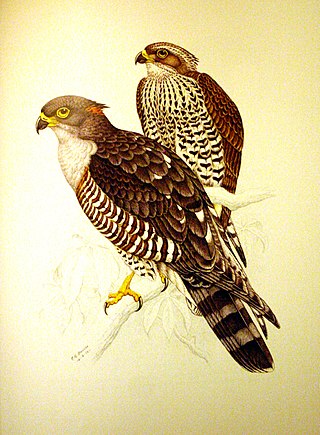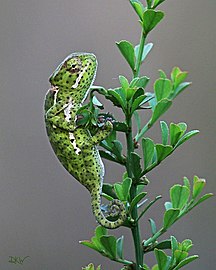
Chameleons or chamaeleons are a distinctive and highly specialized clade of Old World lizards with 200 species described as of June 2015. The members of this family are best known for their distinct range of colours, being capable of colour-shifting camouflage. The large number of species in the family exhibit considerable variability in their capacity to change colour. For some, it is more of a shift of brightness ; for others, a plethora of colour-combinations can be seen.

Bradypodion is a genus of chameleons in the family Chamaeleonidae, collectively called South African dwarf chameleons. All species are found in South Africa and most are endemic to this country, but a few can also be found in Eswatini, Lesotho, southernmost Namibia and possibly southernmost Mozambique. They are quite small chameleons where the different species often can be difficult to separate by appearance, although exact location and the intense breeding colours of males are useful for their identification. They are arboreal, but some species are mostly found low in the vegetation.

Chamaeleo is a genus of chameleons in the family Chamaeleonidae. Most species of the genus Chamaeleo are found in sub-Saharan Africa, but a few species are also present in northern Africa, southern Europe, and southern Asia east to India and Sri Lanka.

Jackson's chameleon, also known commonly as Jackson's horned chameleon, the three-horned chameleon, and the Kikuyu three-horned chameleon, is a species of chameleon, a lizard in the family Chamaeleonidae. The species is native to East Africa, and introduced to Hawaii, Florida, and California. There are three recognized subspecies.

The Namaqua chameleon is a ground-living lizard found in the western desert regions of Namibia, South Africa and southern Angola.

Dasypeltis scabra, known as the common egg eater, egg-eating snake or rhombic egg eater, is a species of snake in the family Colubridae. It is endemic to Africa.

The African cuckoo-hawk, or African baza, is a medium-sized raptor in the family Accipitridae so named because it resembles the common cuckoo. It is found in sub-Saharan Africa and along the eastern parts of Southern Africa, preferring dense woodland and forest of either indigenous or exotic trees.

The common chameleon or Mediterranean chameleon is a species of chameleon native to the Mediterranean Basin and parts surrounding the Red Sea. It is the only extant species of Chamaleonidae with a range that naturally extends into Europe.

Trioceros is a genus of lizards in the family Chamaeleonidae, the chameleons, native to lowlands and highlands in the African mainland, ranging from Ethiopia south to Mozambique and west as far as Ghana. Trioceros was considered a subgenus of the genus Chamaeleo until 2009, when it was elevated to full genus level.

Marshall's pygmy chameleon, also called Marshall's leaf chameleon, Marshall's dwarf chameleon, or Marshall's stumptail chameleon, is a species of chameleon found in the forests of Zimbabwe and Mozambique in Africa. It grows from 3.5 to 7.5 cm and feeds on insects. When standing still, it resembles a leaf on a branch.
The spiny-flanked chameleon, also known as the spiny-sided chameleon, is a species of chameleon endemic to Tanzania. It was first described in 1932 by Arthur Loveridge.

The crested chameleon, also known as the sail backed chameleon, is a species of chameleon native to forests and semi-open wooded habitats in Central Africa.

The graceful chameleon is a species of chameleon native to sub-Saharan Africa. It is commonly around a foot long. Because of its abundance, it is heavily exploited by the pet trade.

The smooth chameleon is a species of chameleon native to Sub-Saharan Africa. It is bluish-green and has small scales. Its body is very slender, and it is similar to Chamaeleo senegalensis.

Owen's chameleon, also commonly known as Owen's three-horned chameleon, is a species of lizard in the family Chamaeleonidae. The species is native to forests in central Africa. Named after British naval officer and explorer William Fitzwilliam Owen, it was first described in 1831 by the naturalist John Edward Gray, and is the type species of the genus Trioceros.

Rieppeleon kerstenii is species of chameleon, a lizard in the family Chamaeleonidae. The species is endemic to East Africa. There are two subspecies.
Tropidosaura montana, also known commonly as the common mountain lizard and the green-striped mountain lizard, is a species of lizard in the family Lacertidae. The species is endemic to South Africa. There are three recognized subspecies.

Trioceros ellioti, also known commonly as Elliot's chameleon, Elliot's groove-throated chameleon, and the montane side-striped chameleon, is a species of lizard in the family Chamaeleonidae. The species is indigenous to Africa.

Trioceros goetzei, also known commonly as Goetze's chameleon, Goetze's whistling chameleon, and the Ilolo chameleon, is a species of lizard in the family Chamaeleonidae. The species is native to eastern Africa. There are two recognized subspecies.
Trioceros harennae, also known commonly as the Harenna hornless chameleon, is a species of lizard in the family Chamaeleonidae. The species is endemic to Ethiopia. There are two recognized subspecies.






















